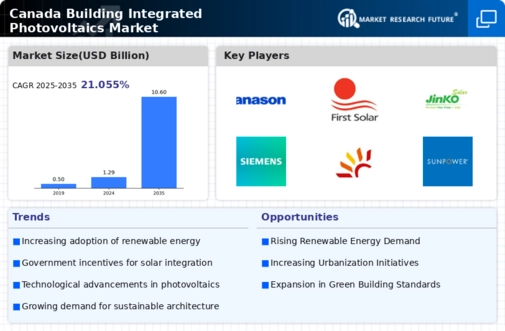Rising Energy Costs
The escalating costs of traditional energy sources in Canada are driving interest in the building integrated-photovoltaics market. As energy prices continue to rise, homeowners and businesses are increasingly seeking alternative energy solutions. The integration of photovoltaic systems into building designs not only reduces reliance on grid electricity but also offers potential savings on energy bills. In 2025, energy costs in Canada have surged by approximately 15% compared to previous years, prompting a shift towards renewable energy sources. This trend indicates a growing market for building integrated-photovoltaics, as consumers look for ways to mitigate rising energy expenses while contributing to environmental sustainability.
Government Incentives and Rebates
Government initiatives aimed at promoting renewable energy adoption are significantly impacting the building integrated-photovoltaics market. In Canada, various provinces offer financial incentives, such as rebates and tax credits, to encourage the installation of photovoltaic systems. For instance, the federal government has allocated over $1 billion in funding for renewable energy projects, which includes support for building integrated-photovoltaics. These incentives not only lower the initial investment costs but also enhance the return on investment for consumers. As awareness of these programs increases, more individuals and businesses are likely to invest in building integrated-photovoltaics, thereby expanding the market.
Increased Awareness of Climate Change
The heightened awareness of climate change and its impacts is influencing consumer behavior in Canada, particularly regarding energy consumption. As individuals and businesses become more conscious of their carbon footprints, there is a growing demand for sustainable energy solutions, including the building integrated-photovoltaics market. Surveys indicate that over 70% of Canadians are willing to invest in renewable energy technologies to combat climate change. This shift in consumer mindset is likely to drive the adoption of building integrated-photovoltaics, as more people seek to align their energy choices with their environmental values.
Urbanization and Infrastructure Development
Ongoing urbanization in Canada is creating a favorable environment for the building integrated-photovoltaics market. As cities expand and new infrastructure projects emerge, there is a growing opportunity to incorporate photovoltaic systems into building designs. Urban areas are increasingly focusing on sustainable development, and integrating solar technology into new constructions aligns with these goals. In 2025, urban centers are projected to see a 20% increase in new building projects, many of which are expected to include building integrated-photovoltaics. This trend suggests a robust market potential as urban planners and architects prioritize energy-efficient designs.
Technological Innovations in Solar Materials
Advancements in solar technology are enhancing the appeal of the building integrated-photovoltaics market. Innovations in materials, such as thin-film solar cells and building-integrated photovoltaics (BIPV), are making it easier to incorporate solar energy solutions into architectural designs. These technologies not only improve the aesthetic appeal of buildings but also increase energy efficiency. In 2025, the market for advanced solar materials is expected to grow by 25%, driven by demand for more efficient and visually appealing photovoltaic solutions. This growth indicates a shift towards integrating solar technology into everyday building practices, further propelling the market.























Leave a Comment